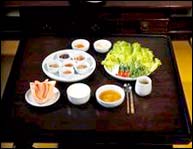|
|
|

Ssam: Rice, pork and spicy wrapped with lettuce
 sam, a favorite Korean cuisine, is easy to prepare and simple to eat, and has long been known as a food of the common people. Koreans eat ssam by putting rice on a green leafy vegetable, topping it with a special soybean paste called ssamjang and wrapping the leaf around the whole mixture. The most commonly used vegetable leaves are lettuce, squash leaves, young Chinese cabbage leaves, sesame leaves and crown daisy leaves. There are many seasonal variations of ssam and seaweed is also sometimes used.
sam, a favorite Korean cuisine, is easy to prepare and simple to eat, and has long been known as a food of the common people. Koreans eat ssam by putting rice on a green leafy vegetable, topping it with a special soybean paste called ssamjang and wrapping the leaf around the whole mixture. The most commonly used vegetable leaves are lettuce, squash leaves, young Chinese cabbage leaves, sesame leaves and crown daisy leaves. There are many seasonal variations of ssam and seaweed is also sometimes used.
The seasoning used might be soybean paste, red pepper paste or a combination of soybean and red pepper paste and sesame oil. Other sauces used are ssam gochujang (red pepper paste mixed with ground beef and sesame oil) and ssam doenjang(soybean paste mixed with ground beef and pyogo mushrooms). The true taste of ssam depends to a great extent on the seasonings used. The origins of ssam can be traced back to the Three Kingdom Period (57 B.C-A.D 668), when lettuce ssam was eaten.
Even today, lettuce ssam is the most popular among Koreans, who might also add parsley and thin green onions to the lettuce leaf. One special type of ssam is called bokssam and is traditionally eaten on the first full moon day of the lunar calendar. Koreans eat ssam on this day, but now it is called bokssam, bok meaning fortune or luck and ssam meaning wrapping. Therefore, you are wrapping your fortune and eating it, bringing luck for the coming year. This was even more significant for Koreans of the past whose main livelihood and staple food was rice, for the abstract concept of fortune became materialized as rice.
Since this first full moon day came before the beginning of the year's farming, it also came to represent a prayer for a good harvest. Another type of ssam is called gujeolpan and is made of small wheat pancakes wrapped around slices of vegetables and meat. As opposed to other types of ssam, gujeolpan was mainly a dish for the upper classes and royalty.
english.tour2korea.com
|
|
|
